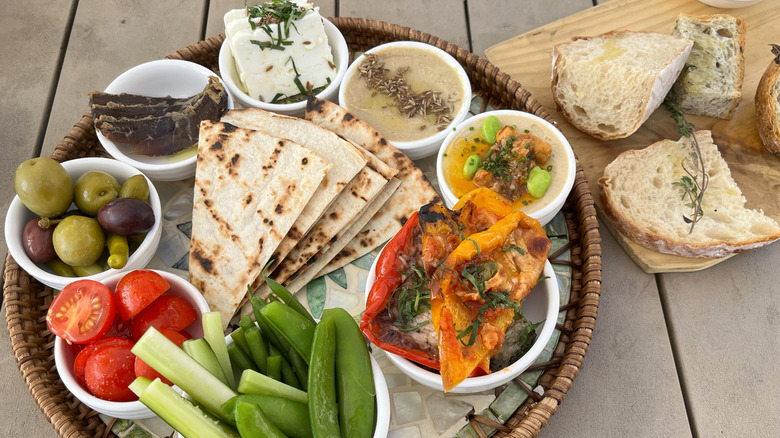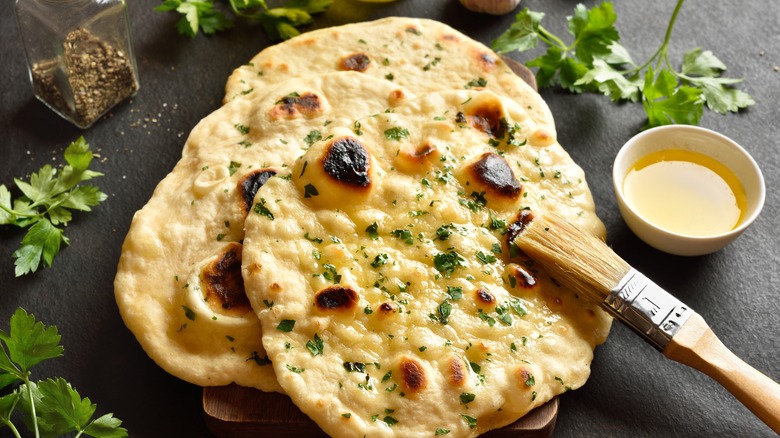Pita Bread Vs Naan: What's The Difference?
Flatbreads like pita and naan have reigned supreme in the Middle East and South Asia for thousands of years, enjoyed as accompaniments to all sorts of tasty meals. Over time, these two foods have gained popularity outside their home regions, thanks to their versatility. While the two baked goods resemble each other on a surface level, they do have their differences.
Pita bread dates back about 4,000 years, and became most popular throughout the Mediterranean and Middle Eastern regions. During the rise of the Persian Empire, which encompassed both regions from 559 B.C. to 331 B.C., the Persian language influenced the name of another, newer flatbread: naan, originating from India. In Persian, bread baked on hot pebbles is called "nân-e sangak," which is where the Indian bread gets its name.
As explained by their overlap in roots, both pita and naan are traditionally cooked in hot hearth ovens that reach much higher temperatures than those used for modern baked breads. Both baked goods are also types of leavened bread, marked by the use of yeast, either natural or manufactured. Despite their historical and regional overlap, however, there are a few notable differences — namely texture, taste, shape, proofing, and use.
What is pita bread?
The base ingredients and methods for making pita bread have remained largely unchanged, apart from the use of man-made yeast as a modern advancement. In ancient times, rudimentary pita dough made of flour and water was left to ferment and absorb natural yeast. Even today, the process of making pita involves a lengthier proofing period than with naan. Modern pita dough, made with only water, flour, yeast, and salt, is left to ferment for 15 minutes to an hour, followed by one or two rounds of proofing.
Between fermentation and proofing, the pita dough is portioned into balls, shaped using one's palm and a flat surface, and rolled into flattened circles. The dough is then baked in a hot hearth oven at temperatures ranging from 698 to 932 degrees Fahrenheit. This intensely high heat is what creates pita's signature air pocket, perfect for filling with your favorite sandwich ingredients. When the dough is placed in the hearth, a crust immediately forms along the base and edges, while steam trapped inside causes the dough to puff up.
The bread's iconic pocket makes it ideal for wraps like gyros, but pita can also be used to make no-crust peanut butter and jelly sandwiches. It tends to be crispier and slightly drier than naan, with a mild flavor that makes it a perfect vessel for other foods. Pita is fantastic for dipping into baba ghanoush or hummus, and tends to have a more rigid structure, making it great for scooping yummy seasonal chopped salads or other finely-chopped veggie dishes.
What is naan?
In contrast to the more ancient pita, the first mention of naan was in 1300 A.D. As its popularity spread throughout India, naan became a fixture in the diets of royalty by the 1500s, and eventually a staple across all social classes. Today, naan is synonymous with Indian cuisine. This bread uses a type of enriched dough, with fat often added via eggs, milk, and/or ghee (clarified butter), along with buttermilk or yogurt. This gives it a softer, chewier texture than the un-enriched pita — excellent for sopping up every last drop of sauce from a flavorful curry.
Unlike the hearth ovens used for pita, naan is baked in a dome-shaped clay oven known as a tandoor, which reaches temperatures at or above 900 degrees Fahrenheit. This leads to a shorter bake time and creates naan's signature charred bubbles, while creating a minimal rise in the dough. Unlike pita, naan dough is hand-stretched before baking, giving it its unique teardrop shape with smaller air pockets peppered throughout the bread.
Naan can also be enhanced with additional flavors. Traditional garlic naan features garlic incorporated into melted ghee, which is brushed over the baked naan as a finishing touch. Different regions in India showcase unique flavor combinations: Kashmiri naan is filled with candied cherries and golden raisins for a sweeter variation, while keema naan is more savory, stuffed with tender spiced lamb. Another easy way to elevate homemade naan is by topping it with minced garlic and cilantro.



